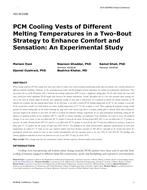Description
Phase change material (PCM) cooling vests have been shown to reduce heat strain of humans performing many types of activities for a certain duration at different ambient conditions. However, as the environment gets hotter and for prolonged activity durations, the cooling vest performance deteriorates. This necessitates the use of PCM packets with a relatively low melting temperature (MT) to have a significant cooling effect. On the other hand, two issues will arise, which first entail additional PCM weight that increases the human metabolism. Second, discomfort due to a too cold sensation upon wearing the vest at the start of activity might be present, since significant cooling at that time is unnecessary. It is proposed to divide the activity duration, of 50 minutes, for example, into two equally-timed bouts. In the first bout, a vest with a certain PCM melting temperature of 28 °C, for example, is used and in the second bout, another vest with packets of a lower melting temperature of 21 °C, for example, is used. Thus, applying the proposed strategy would provide the needed cooling effect in the initial warming up stage and in the second stage where a stronger cooling effect is desired, while only carrying the necessary weight of the packets in each bout. In order to examine the proposed strategy, experiments on six male participants performing cycling for 50 minutes at moderate activity in hot conditions (40 °C and 40 % relative humidity) are performed. Four conditions are tested to assess the proposed strategy: 1) no vest is worn, 2) one vest filled with 28 °C packets is worn for the whole 50-min period (MT-28), 3) one vest filled with 21 °C packets is worn for the whole 50-min period (MT-21) and 4) a vest filled with 28 °C packets is worn for the first 25-min bout followed by wearing a second vest filled with 21 °C packets for the second 25-min bout (MT-28-21). The findings of the study showed further significant improvements in local skin temperatures by about 4.5 °C from no vest case, thermal comfort and torso thermal sensation in MT-28-21, especially in the second bout where the participants would have started to reach or have reached uncomfortable and hot sensation levels as in cases MT-21 and MT-28. The findings also showed significant reduction in sweat rate from no vest case in case MT-21 only, by about 18%.
Keywords: Phase change material; hot environment, human thermal responses; thermal comfort and sensation.
Citation: 2018 Annual Conference, Houston, TX, Conference Papers
Product Details
- Published:
- 2018
- Number of Pages:
- 10
- Units of Measure:
- Dual
- File Size:
- 1 file , 1.5 MB
- Product Code(s):
- D-HO-18-C026




